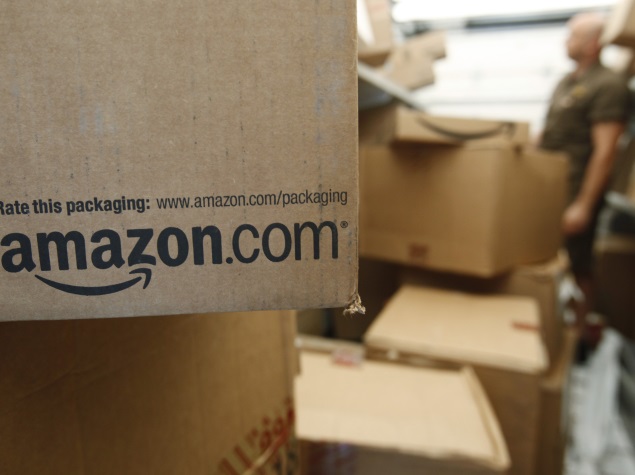- Home
- Internet
- Internet Features
- Amazon's Far Reaching Ambitions, Lack of Profits, Unnerve Investors
Amazon's Far-Reaching Ambitions, Lack of Profits, Unnerve Investors

Some on Wall Street wonder if Amazon may have bitten off more than it can chew. After an unusually busy first half of the year that saw the online retailer spend on developing everything from mobile phones and Hollywood-style production to grocery deliveries, investors are ready to see it curtail its ambitions and start delivering sustainable profits.
(Also see: Amazon's Spending Spree Raises Margin Concerns)
Or at least offer evidence that Bezos' ever-increasing investments are going to soon generate appealing returns for its main online retailing business.
"It does get frustrating when they continue to spend quarter after quarter and they don't let the revenue flow through," said Michael Scanlon, who manages $3.5 billion at Manulife Asset Management and holds shares of Amazon. "I'm definitely ready for profits."
Others argue that easing off on the throttle now may thwart its goal of becoming the Wal-Mart of online retail. That is particularly the case as China's Alibaba - which handles more ecommerce than Amazon and eBay Inc combined - slowly develops a U.S. consumer presence and prepares for an initial public offering in the U.S.
Big selling point
Bezos insists on taking the long view. In his letter to shareholders last year, he responded to criticism about spending by saying investing in a "just-in-time fashion would be too clever by half."
Its increasing share of the retail dollar is still a big selling point for investors.
"You have to take a long-term perspective and you have to buy in that you're going to see solid topline growth," said Needham & Co analyst Kerry Rice.
But that market share grab comes at a price a price that was highlighted in its second-quarter results issued on Thursday. Amazon reported its largest quarterly loss since 2012 as operating expenses rose 24 percent, led by a 40 percent surge in spending on technology and content.
Its shares fell 9.6 percent on Friday, wiping out about $16 billion of value. The company has now fallen short of Wall Street's earnings expectations in seven of the past nine quarters.
Perhaps worse, it predicted an operating loss of up to $810 million for the current third quarter, the biggest quarter-on-quarter reversal in profitability since 2003, B. Riley analysts estimated. Included is $410 million in stock-based compensation in the third quarter, but excluded are "acquisitions, investments, restructurings."
Investors say they are concerned about not only Amazon spending every dollar that comes in the door but also the lack of disclosure about where it is being spent.
"Most companies with the kind of gross revenue Amazon has are not posting these kind of losses," said Michael Yoshikami, CEO of Destination Wealth Management, which sold its stake in Amazon last year. "You've got to give more information to justify faith in the name."
But Amazon has always kept its data close, even basic details such as how many Kindle tablets it has sold or the precise number of subscribers to its Amazon Prime free shipping and media service, citing competitive reasons.
Scanlon said that greater disclosure "would help you do things like measure return on investments. You can start to get your arms around more what the duration of the spending will be."
Tough to swallow
Two areas that have proven hard for some to swallow are a panoply of new devices based on a heavily modified and less-established version of Google's Android, and Amazon's move into program production.
This week, Amazon launched the $649 Fire Phone (Review), but it failed to impress reviewers. The phone joins a Fire streaming box and a line of tablets and e-readers - most sold at prices close to their cost to produce and get to market - in its drive to galvanize sales of digital books and media.
Amazon's foray into TV - from "Alpha House" starring John Goodman to just-announced kids show "Annedroids" - has never garnered Netflix-like acclaim. Yet it intends to devote more than $100 million to original video content this quarter.
"There's a lot of stuff they're doing that's questionable," said S&P Capital IQ analyst Tuna Amobi, who has a "sell" rating on Amazon, referring in particular to Amazon's content and hardware endeavors.
Investors might be soothed if Amazon did a share buyback, Scanlon said, adding it was unlikely. While Amazon has more than $5 billion of cash and cash equivalents as of June, analysts say there's little percentage in Amazon buying its own shares, given their lofty valuation even after a slump this year.
Some assessments tag Amazon's shares with a highly-overvalued warning sign.
According to Thomson Reuters StarMine, Amazon's shares carry an intrinsic worth of $36.37 - or about a tenth of its current price - making the stock one of the most overvalued names in its universe of more than 4,000 U.S. companies. StarMine calculates its intrinsic value figure using growth expectations for the coming decade, and it suggests that at its current price, investors are discounting a much faster growth rate than Amazon could hope to achieve in coming years.
B. Riley, which downgraded Amazon to neutral from buy on Friday, argued it was hard to justify its valuation given "compromised cash flows."
"There's nothing wrong with spending to diversify your business, but it has to be a focused manner as opposed to throwing spaghetti on the wall and seeing what sticks," Amobi said. "They're a public company, they need some sensitivity" to shareholders.
© Thomson Reuters 2014
Catch the latest from the Consumer Electronics Show on Gadgets 360, at our CES 2026 hub.
Related Stories
- Samsung Galaxy Unpacked 2025
- ChatGPT
- Redmi Note 14 Pro+
- iPhone 16
- Apple Vision Pro
- Oneplus 12
- OnePlus Nord CE 3 Lite 5G
- iPhone 13
- Xiaomi 14 Pro
- Oppo Find N3
- Tecno Spark Go (2023)
- Realme V30
- Best Phones Under 25000
- Samsung Galaxy S24 Series
- Cryptocurrency
- iQoo 12
- Samsung Galaxy S24 Ultra
- Giottus
- Samsung Galaxy Z Flip 5
- Apple 'Scary Fast'
- Housefull 5
- GoPro Hero 12 Black Review
- Invincible Season 2
- JioGlass
- HD Ready TV
- Laptop Under 50000
- Smartwatch Under 10000
- Latest Mobile Phones
- Compare Phones
- Honor Win RT
- Honor Win
- Xiaomi 17 Ultra Leica Edition
- Xiaomi 17 Ultra
- Huawei Nova 15
- Huawei Nova 15 Pro
- Huawei Nova 15 Ultra
- OnePlus 15R
- Asus ProArt P16
- MacBook Pro 14-inch (M5, 2025)
- OPPO Pad Air 5
- Huawei MatePad 11.5 (2026)
- Xiaomi Watch 5
- Huawei Watch 10th Anniversary Edition
- Acerpure Nitro Z Series 100-inch QLED TV
- Samsung 43 Inch LED Ultra HD (4K) Smart TV (UA43UE81AFULXL)
- Asus ROG Ally
- Nintendo Switch Lite
- Haier 1.6 Ton 5 Star Inverter Split AC (HSU19G-MZAID5BN-INV)
- Haier 1.6 Ton 5 Star Inverter Split AC (HSU19G-MZAIM5BN-INV)

















